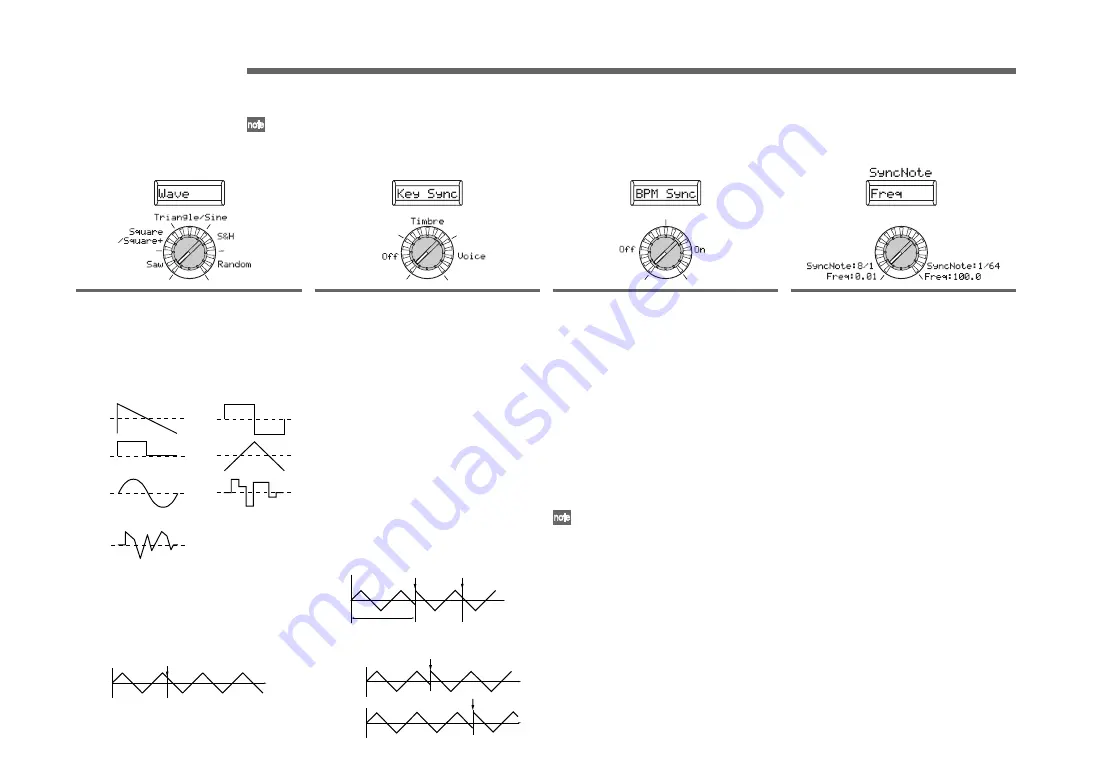
44
18. LFO 1, 19. LFO 2
Each timbre contains two LFOs. An LFO produces a cyclic change that can be used to modulate the pitch, tone, or volume of the sound. Use knob [1] to select the
LFO waveform, and specify the method of key synchronization (knob [2]) and tempo synchronization (knobs [3] and [4]).
LFO1 and LFO2 can be used as Virtual Patch sources to apply modulation to a variety of parameters. (
☞
p.45)
Knob [2]
Key Sync
[Off, Timbre, Voice]
Specifies how the LFO will be applied to a
voice when note-on occurs.
Off:
The LFO phase will not be reset when
note-on occurs (
☞
Figure 18-1).
Timbre:
The phase of the LFO will be re-
set by the first note-on that occurs from a
condition of no keys being held; it will not
be reset for subsequently played voices
(
☞
Figure 18-2).
Voice:
The LFO phase will be reset at each
note-on, and modulation of differing
phases will apply to each voice (
☞
Figure
18-3).
Knob [3]
BPM Sync
[Off, On]
Specifies whether the LFO cycle will be
synchronized to the internal tempo or to
an external MIDI Clock.
Off:
The LFO will not be synchronized. It
will operate at the frequency specified by
the “Freq” (knob [4]) parameter.
On:
The LFO will be synchronized to the
[TEMPO] knob or to MIDI Clock messages
from an external device. The 42. MIDI page
“Clock” parameter determines the sync
source.
If “BPM Sync” is On, selecting
LFO1Freq or LFO2Freq as “Dest” in
PATCH 1–6 will have no effect.
Knob [4]
Freq (Frequency)
[0.01Hz...100.0Hz]
Specifies the frequency of the LFO. Increas-
ing this value will result in a faster fre-
quency. This parameter will be displayed
and can be set only if “BPM Sync” is Off.
SYNC NOTE
[8/1...1/64]
Specifies the LFO frequency as a note value
derived from the tempo specified by the
[TEMPO] knob. This parameter is only avail-
able when “BPM Sync” is On.
8/1:
One LFO cycle = 32 beats in length.
4/1:
One LFO cycle = 16 beats in length.
1/1:
One LFO cycle = 4 beats in length.
1/2:
One LFO cycle = 2 beats in length.
1/4:
One LFO cycle = 1 beat.
1/8:
Two LFO cycles = 1 beat.
1/64:
Sixteen LFO cycles = 1 beat.
Knob [1]
WAVE (LFO1)
[Saw, Square, Triangle, S&H, Random]
WAVE (LFO2)
[Saw, , Sine, S&H, Random]
Selects the LFO waveform.
Triangle
Sine
Saw
Square
S&H
Amplitude changes irregularly
(Sample & Hold)
Random
Figure 18-1: Key Sync off
Note on
Figure 18-2: Key Sync Timbre
Note on
Note on
Note all off
Figure 18-3: Key Sync Voice
Note on
Note on
1VOICE
2VOICE
LFO (Low Frequency Oscillator)
The LFO (Low Frequency Oscillator) is an oscillator that produces a relatively slow (low-
frequency) oscillation, and is used to apply cyclic modulation to various aspects of the
sound. Some typical ways to use LFO are vibrato (use LFO to raise and lower the pitch),
wah (use LFO to raise and lower the cutoff frequency), and tremolo (use LFO to raise and
lower the volume). You can select LFO as a Virtual Patch source, select the desired param-
eter as the destination, and apply modulation to produce various effects. The
R3
provides
special parameters that let you use the LFO to apply modulation. For LFO1, this parameter
is “LFO1Int” (knob [4] when the 5. OSC1 page “OSC Mod” (knob [2]) is set to Waveform.
For LFO2, this is the 4. Pitch-B page “VibrtInt” parameter (knob [2]).
Summary of Contents for R3
Page 1: ...1 E ...
Page 2: ...ii ...
















































